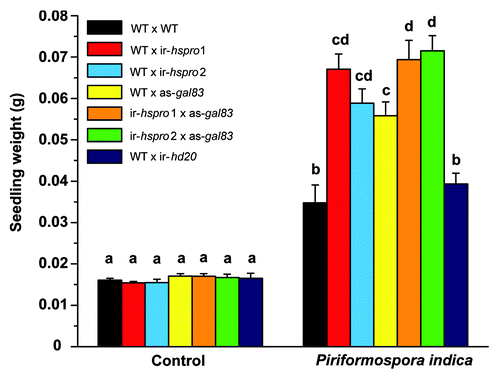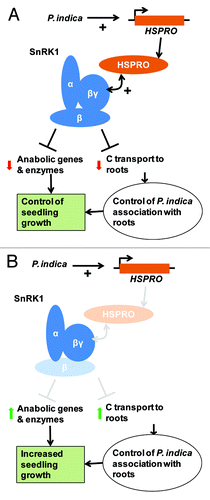Figures & data
Figure 1. Differential growth promotion of Nicotiana attenuata seedlings mediated by Piriformospora indica. After seven days of germination, N. attenuata seedlings were transferred onto PNM (plant nutrient medium)Citation1 and inoculated with P. indica culture or a medium control. After 14 d of incubation in these conditions, the fresh biomass of seedlings was determined with a microbalance (n = 8–17; bars denote standard error of the mean). Statistical analysis was conducted using one way-ANOVA with Tuckey post-hoc test. The letters on top of the bars denote significant differences between genotypes and treatments and the P-values associated with the analysis are summarized in .

Table 1. One way-ANOVA and Tuckey post-hoc test results from the comparison of Piriformospora indica-colonized seedlings presented in
Figure 2. Hypothetical model for the role of HSPRO and SnRK1 in regulation of seedling growth during interaction of N. attenuata plants with the growth promoting fungus P. indica.(A) The interaction of P. indica with roots of N. attenuata seedlings induces the expression of HSPRO via transcriptional activation.Citation1 HSPRO interacts with the βγ-subunit of SnRK1Citation2 and this interaction activates SnRK1 by still unknown mechanisms. Activation of SnRK1 controls the allocation of carbon (C) from photo-assimilates to the rootsCitation3 and negatively regulates the expression of anabolic genes and enzymes (references in text). These mechanisms either directly or indirectly affect seedling growth during interaction with P. indica. (B) In plants with reduced levels of HSPRO expression (e.g., triggered by gene silencing) or SnRK1 activity (e.g., triggered by silencing of the β-subunit), the negative regulation of C transport to roots, anabolic gene expression and metabolic enzyme activities by SnRK1 is lessened and seedling growth is enhanced via differential growth promotion by P. indica.
